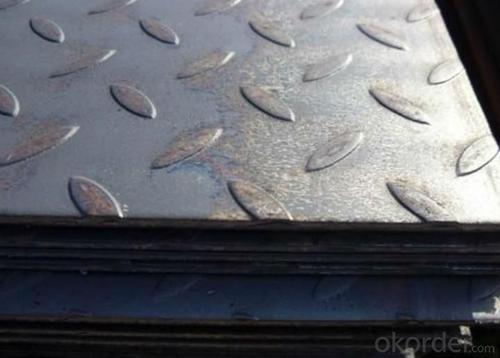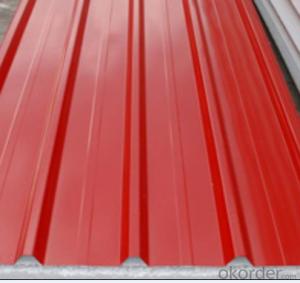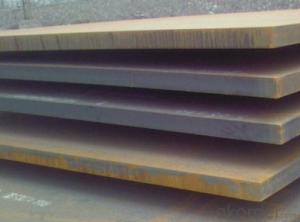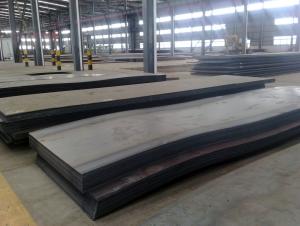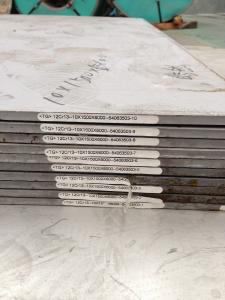Hot Rolled Dimond Sheet
- Loading Port:
- Xingang Port
- Payment Terms:
- TT or LC
- Min Order Qty:
- 100MT m.t.
- Supply Capability:
- 10000MT/Year m.t./month
OKorder Service Pledge
OKorder Financial Service
You Might Also Like
Specification of Hot Rolled Dimond Sheet:
1.Advantages of our Hot Rolled Dimond Sheet:
a) The unfairness of our dimond sheet must be less than 10mm each meter
b) The surface of our hot rolled dimond sheet is free from bubble, scab, crack, fold, edge delamination and so on.
2. Other details of Hot Rolled Dimond Sheet
Standard | EN10025 |
Grade | S275JR |
Thickness | 2.5-15mm |
Width | 1000mm 1220mm 1250mm 1500mm 2000mm 2500mm 3000mm |
Length | 4000-12000mm |
Note: Dimension of our hot rolled dimond sheet can be made according to your requirements, we can futher discuss about it.
3. The regular sections we provide are shown in the below table:
Base Thickness(MM) | Allowed Tolerance of Base Thickness(%) | Theoretical Mass (KG/M²) | ||
The Pattern | ||||
Rhombus | Beam | Pea | ||
2.5 | ±0.3 | 21.6 | 21.3 | 21.1 |
3.0 | ±0.3 | 25.6 | 24.4 | 24.3 |
3.5 | ±0.3 | 29.5 | 28.4 | 28.3 |
4.0 | ±0.4 | 33.4 | 32.4 | 32.3 |
4.5 | ±0.4 | 37.3 | 36.4 | 36.2 |
5.0 | 0.4~-0.5 | 42.3 | 40.5 | 40.2 |
5.5 | 0.4~-0.5 | 46.2 | 44.3 | 44.1 |
6.0 | 0.5~-0.6 | 50.1 | 48.4 | 48.1 |
7.0 | 0.6~-0.7 | 59.0 | 52.5 | 52.4 |
8.0 | 0.7~-0.8 | 66.8 | 56.4 | 56.2 |
4. Chemical Composition of Hot Rolled Dimond Sheet:
Standard | Grade | C(%)max | Mn(%)max | P | S |
EN10025 | S275JR | 0.25 | 1.6 | 0.045 | 0.045 |
Note: Here, we just take the hot rolled checkered steel sheet according to S275JR as example. We are also able to provide SGS test report for checkered steel sheet as per other material grade.
Applications of Hot Rolled Dimondl Sheet:
1.Definition: The hot rolled dimond sheet with raised pattern on surface. The raised pattern could be shaped as rhombus,bean or pea. There is not only one kind of pattern on the checkered steel sheet, but also a complex of two or more than two kinds of pattern on surface of one checkered sheet. It also could be called as grid steel sheet.
2.Character: The Hot Rolled Dimond Sheet possesses a variet of advantages, such as beauty in appearance,skip resistance and saving steel material.Generally speaking,in order to test the mechanical property or the quality of hot rolled checkered steel sheet, the shaping rate and the pattern height should be tested primarily.
3. In conclusion, the hot rolled dimond sheet can usually be used in the industry of ship-building,boiler,automobil,tractor,train- building and architecture. In details, there are many demands for hot rolled checkered steel plate to make floor,ladder at workshop,work frame pedal,ship deck,car floor and so on.
Package & Delivery of Hot Rolled Dimond Sheet:
1. The items to be prepared for packing include: narrow steel strip, crude steel belt or edge angle steel, kraft paper or galvanized sheet.
2. The hot rolled checkered steel plate should be wrapped with kraft paper or galvanized sheet ouside, and it should be bundled with narrow steel strip, three or two narrow steel strip in longitudinal direction,and the other three or two strips in transverse direction. Furthermore, in order to fix the hot rolled checkered steel plate and avoid the strip at edge shall be broken, the crude steel belt cut into square should be put under the narrow steel strip on the edge. Of course, the hot rolled checkered steel plate could be bundled without kraft paper or galvanized sheet. It depends on customer’s requirement.
3. In consideration of the transportaion from mill to loading port, the truck will be usually used. And the maximum quantity for each truck is 40mt.
4. In conclusion, we could do in accordance with customer's request.
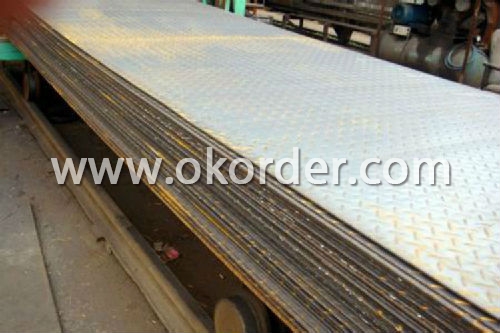

Production Flow of Hot Rolled Dimond Sheet:
1.The steel raw materials are first melted in an electric furnace. They are subjected to at least 12 hours of intense heat.
2.The mixture is cast into either large rectangular blooms, slabs or bar-like billets, before taking on a semisolid form.
This initial form of steel is then processed via forming operations that include hot rolling into bars, wires, plates and slabs.
3.The steel is subjected to annealing. This is a heat treatment in which the metal is first heated and then cooled under extreme, controlled conditions. The metal is thus treated for internal stresses and is duly softened and strengthened. This processing is also referred to as 'age hardening'. It requires careful monitoring of temperature and heating and cooling times. The aging temperature affects metal properties massively; while lower temperatures cause high strength and low fracture toughness (i.e., more brittle than ductile), higher temperatures result in a tougher material of lower strength (i.e., more ductile than brittle). Rapid cooling can produce a tough steel with no significant loss in strength. The heat treatment given to stainless steel depends on the type and grade of steel being produced.
4. Annealing or the heat treatment can lead to the development of a precipitate, known as scale. The scale can be removed via several methods, such as pickling, (nitric-hydrofluoric acid bath),electrocleaning(application of an electric current, using phosphoric acid and a cathode), etc.
5. Descaling of the material is introduced into the manufacturing process at different times, depending on the type of steel being produced. While the bar and wire forms have to be additionally treated with hot rolling,forging and extruding, the sheet and strip forms go through annealing after hot rolling.
6. Cutting operations in the manufacturing process are essential in obtaining the desired shape and size of the end product. Mechanical cutting involves the use of guillotine knives and high-speed steel blades for blanking (punching out the shape by shearing) and nibbling (cutting out a series of overlapping holes). It is also cut via flame cutting, a process that involves the use of a flame generated by oxygen, propane and iron powder. The plasma jet cutting method uses an ionized gas column to melt and cut the metal.
7. Manufacturing end products involve further shaping via heat-rolling, pressing, forging and extrusion. The material is then joined via welding and given the desired shape.
- Q: Are the steel sheets available in different thickness tolerances?
- Certainly, there are various thickness tolerances for steel sheets that are readily available. Steel producers create sheets with diverse thicknesses to accommodate different purposes and demands. These tolerances are determined by established standards within the industry and can differ based on the steel type and intended application. In construction, for instance, tighter tolerances might be mandatory to guarantee the structural soundness, while in manufacturing sectors like automotive or aerospace, precise tolerances may be indispensable to meet design requirements. Through offering steel sheets in varying thickness tolerances, manufacturers allow customers to select the most fitting product for their individual requirements.
- Q: Are the steel sheets suitable for agricultural applications?
- Yes, steel sheets are suitable for agricultural applications. Steel is a versatile and durable material that can withstand harsh weather conditions and provide long-term structural support. Steel sheets can be used in various agricultural applications such as constructing farm buildings, barns, sheds, and storage facilities. They can also be used for fencing, roofing, and siding purposes. Steel sheets offer excellent strength and resistance to pests, fire, and rot, making them ideal for protecting agricultural equipment and crops. Additionally, steel is recyclable, which makes it an environmentally-friendly choice for sustainable farming practices. Overall, steel sheets are a reliable and cost-effective solution for various agricultural applications.
- Q: What is the difference between a perforated and expanded steel sheet?
- A perforated steel sheet and an expanded steel sheet are both types of metal sheets commonly used in various industries. However, they differ in terms of their manufacturing process and resulting characteristics. Perforated steel sheets are created by punching or drilling holes into a solid steel sheet. These holes can be of various shapes, sizes, and patterns, depending on the desired application. The holes in a perforated steel sheet allow for the passage of air, light, sound, or fluids, making them suitable for applications that require ventilation, filtration, or acoustic properties. Perforated steel sheets are commonly used in industries such as architecture, automotive, filtration, and mining. On the other hand, expanded steel sheets are produced by a unique manufacturing process known as expanding. The process involves cutting and stretching a solid steel sheet, resulting in a mesh-like pattern with diamond-shaped openings. The stretching process imparts strength and rigidity to the steel sheet while also reducing its weight. Expanded steel sheets are versatile and can be used in applications such as walkways, platforms, fencing, grating, and reinforcement. In summary, the main difference between a perforated and expanded steel sheet lies in their manufacturing process and resulting characteristics. Perforated steel sheets have holes punched or drilled into them, allowing for the passage of air, light, sound, or fluids. Meanwhile, expanded steel sheets are created by cutting and stretching a solid sheet, resulting in a mesh-like pattern with diamond-shaped openings. Both types of sheets have their unique advantages and are chosen based on the specific requirements of the application.
- Q: How do steel sheets perform in terms of chemical resistance?
- Steel sheets generally have good chemical resistance due to their high corrosion resistance. However, their exact performance can vary depending on the specific type of steel and the chemicals they come into contact with.
- Q: Can steel sheets be used for industrial machinery?
- Yes, steel sheets can be used for industrial machinery. Steel is a versatile and durable material that is commonly used in the manufacturing of various types of industrial machinery due to its strength, resistance to corrosion, and ability to withstand high temperatures and heavy loads. Steel sheets can be easily fabricated and shaped to meet specific requirements, making them suitable for a wide range of industrial applications.
- Q: How do steel sheets perform in impact resistance?
- Steel sheets have excellent impact resistance due to their high strength and toughness. They are able to absorb and distribute the force exerted during an impact, minimizing deformation and damage.
- Q: Can steel sheets be used for storage shelves?
- Yes, steel sheets can be used for storage shelves. Steel is a strong and durable material that can withstand heavy loads, making it suitable for storage shelving systems. Steel sheets can provide a sturdy platform to store items and can be easily customized to fit the desired dimensions and specifications.
- Q: Can steel sheets be used for walkways or platforms?
- Yes, steel sheets can be used for walkways or platforms. Steel is a durable and strong material, making it suitable for supporting heavy loads and providing a safe surface for walking. It is commonly used in industrial settings, construction sites, and other applications where a sturdy and reliable platform is needed.
- Q: What is the typical yield strength of a steel sheet?
- The typical yield strength of a steel sheet can vary depending on the specific grade and thickness of the sheet. However, common steel grades used in construction and manufacturing typically have a yield strength ranging from 250 MPa to 550 MPa.
- Q: How do steel sheets perform in low-temperature environments?
- In low-temperature environments, steel sheets typically demonstrate excellent performance. The presence of low temperatures does not significantly impact the mechanical properties of steel, such as its strength and toughness. Steel possesses a low coefficient of thermal expansion, which means it does not undergo significant contraction or expansion when exposed to temperature fluctuations. This characteristic enables steel sheets to maintain their shape and structural integrity even in cold conditions. Furthermore, steel exhibits remarkable resistance to brittle fracture at low temperatures. It possesses excellent impact resistance, allowing it to absorb energy without fracturing. As a result, steel sheets are suitable for use in low-temperature environments where materials must endure heavy loads or sudden impacts, such as in cold storage facilities or offshore structures in Arctic regions. It is important to note, however, that certain types of steel, particularly those with high carbon content or low alloy steels, may experience reduced toughness and ductility at extremely low temperatures. In such cases, specific precautions may be necessary. These precautions may include utilizing steel grades specially designed for low-temperature applications or implementing appropriate insulation measures to prevent rapid temperature changes. Overall, steel sheets are generally dependable and exhibit excellent performance in low-temperature environments due to their strength, toughness, and resistance to brittle fracture. Nevertheless, the precise performance of steel in cold conditions may vary depending on the composition and quality of the steel employed.
1. Manufacturer Overview
| Location | Tianjin, China |
| Year Established | 2004 |
| Annual Output Value | Above US$ 500 Million |
| Main Markets | China; Europe; America; Southeast Asia |
| Company Certifications | ISO9001、ISO14001、OHSAS18001 |
2. Manufacturer Certificates
| a) Certification Name | |
| Range | |
| Reference | |
| Validity Period |
3. Manufacturer Capability
| a) Trade Capacity | |
| Nearest Port | Tianjin; Qingdao; Dalian |
| Export Percentage | 41% - 50% |
| No.of Employees in Trade Department | 21-50 People |
| Language Spoken: | English; Chinese |
| b) Factory Information | |
| Factory Size: | Above 900,000 square meters |
| No. of Production Lines | 3 |
| Contract Manufacturing | OEM Service Offered |
| Product Price Range | High; Average |
Send your message to us
Hot Rolled Dimond Sheet
- Loading Port:
- Xingang Port
- Payment Terms:
- TT or LC
- Min Order Qty:
- 100MT m.t.
- Supply Capability:
- 10000MT/Year m.t./month
OKorder Service Pledge
OKorder Financial Service
Similar products
Hot products
Hot Searches
Related keywords



